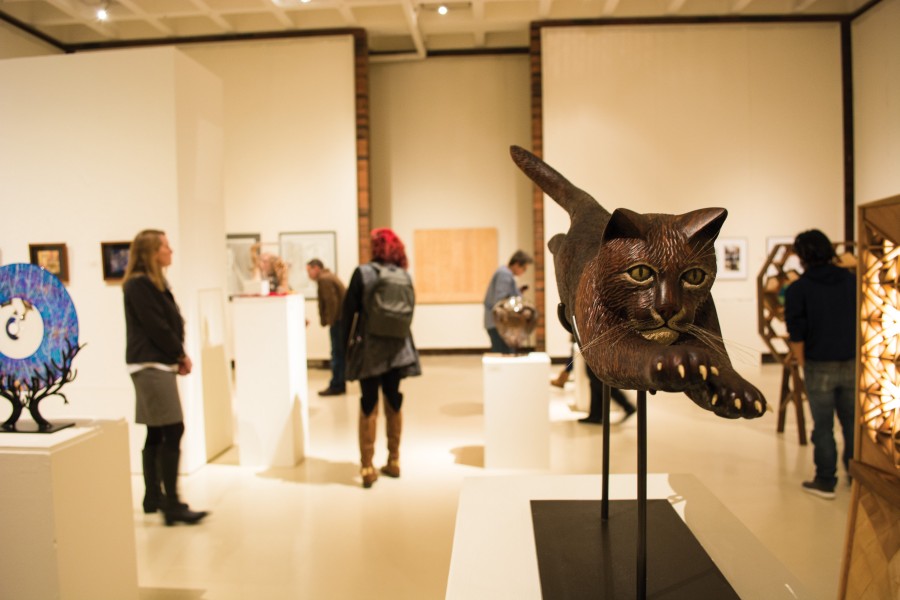Art on campus it’s everywhere
Public art on campus can not only be seen outside, most of it can be found inside different buildings
February 25, 2016
Throughout history, art has taken many forms and been interpreted in many ways. Humans have certainly come a long way from painting on cave walls with squished berries.
“Everyone is incredible and anyone can create art. It is a human heritage, it is primal,” Jason Clifton, a local Ellensburg artist, said. “We have been making art for ages. It is how we can tell history and record our thoughts. You don’t have to just be studying art. Anyone can pick up a brush and paint.”
Today, art is expressed in a variety of ways. Examples of great public art are featured on campus walls, and statues and sculptures scattered outdoors add to the character and uniqueness of Central.
Many students and faculty would be surprised to hear the time, effort and energy that goes into the art they see around campus.
The people behind all the planning and upkeep of Central’s art is the University Art Collection and Selection Committee. Gregg Schlanger is the chair of the committee.
This committee is responsible for not only maintaining Central’s collection, but pieces that are part of the state’s collection.
The art displayed in the SURC does not fall under the justification of the school collection or the state collection. Because the SURC is student-run and owned, it’s the students who commission and maintain their own art, Schlanger said.
Besides that, every building on campus must, by law, designate .05 percent of its budget for art.
Pieces that are commissioned as part of a new building are included in the Washington state collection, meaning that the government owns those particular pieces, said Heather Johnson, former committee member and Central Gallery manager.
Schlanger said,“The process of picking out an artist to complete a piece for [the new Science Phase II building] and all the steps required to achieve the finished product has taken two and a half years.”
The process of finding an artist to complete the project was a complicated one for Schlanger and the committee.
“We begin the process with the committee looking through countless profiles of potential artists who are interested in making a piece of our new building,” Schlanger said. “After going through these profiles, the committee then narrowed their search to a few specific artist.”
The next step was for the selected artists to provide the committee with a more detailed portfolio of their work.
The committee ultimately selected two men from Los Angeles to create a design for the building after months of searching, Schlanger said.
The artists were tasked with creating a design to be approved by the committee.
After the design received approval, it was sent to both the state and the construction company to insure it can be built and all the proper materials can be provided for the artists.
Schlanger couldn’t reveal the entire design, but teased at the scale of the piece.
“Extra cement will have to be poured into the foundation and the ceiling will have to be reinforced to support this structure,” Schlanger said.
The art will be displayed in the lobby of the building.
The piece is not the only new art to be seen on campus.
On Feb. 18, the art department opened a new exhibit in Randall Hall, featuring pieces by eight retired faculty members and a few alumni as well.
This exhibit has a wide variety of pieces that include digital prints, oil pastel, woodwork, glasswork and graphic design.
“Even if you aren’t studying art there is still a lot to learn and absorb from the art displayed here,” Johnson said.
Schlanger couldn’t agree more.
“We are an institution of education, and I believe public art serves us in a couple of ways,” Schlanger said. “First off, as we know, it is culture, but whether it is good or bad, public art helps us to think about it and to be critical. You don’t have to like it. You can be critical because at least you are thinking of it and forming your own opinion. That is what college is about and that is what public art helps us do.”
Schlanger feels that these particular pieces of art are especially important for Central.
“It is a part of our background, since a lot of these pieces are from alumni,” Schlanger said.
Students said, there’s is not a lot of communication about art on campus.
Chris Berg, senior studio arts major, said no one really knows anything about the art or the art scene on campus unless then are studying the subject.
“There isn’t a good sense of community on campus. Most people don’t know about us or what we do. A step in the right direction would be everybody trying to integrate with each other,” Berg said. “Could you imagine what someone from the physics department could help someone make? They can help with the mechanics and an artist could be free to create. I would love to see a piece like that.”
Berg is not the only art student with this opinion.
“I think that the art scene really just stays in the department,” Skyler Crady, senior art major, said. “No one really knows about us here.”
Those in the art department hope that more students at Central come to appreciate art on campus.
“I think that art combines everything in life and creates something everyone can relate to,” Crady said.
Clifton sees art slowly losing value to younger generations.
“This generation is losing its eye to see the master stroke,” Clifton said. “We see the finished product, not all the decisions that go into the art. I hope that people could see all the hard work and time that is put into a piece.”


